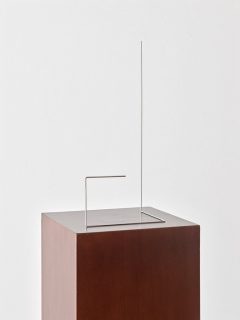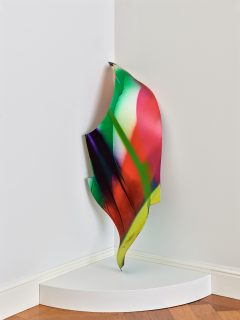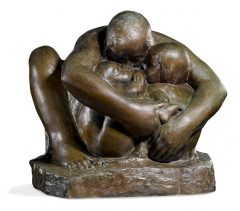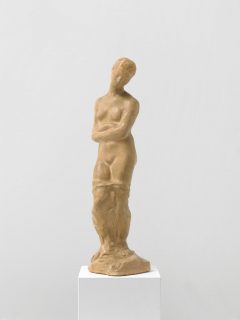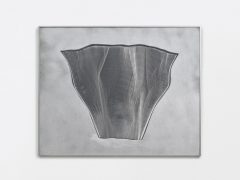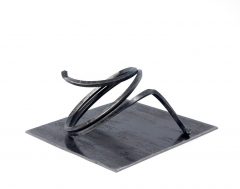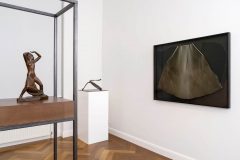Galerie Ludorff, "Skulptur 2", Düsseldorf 2025

Dr. Christina Irrgang
2025
Dr. Christina Irrgang:
"FROM THE EXTERNAL AND THE INTERNAL TOWARDS THE SELF - SCULPTURES FROM OVER 100 YEARS IN THE EXHIBITION SCULPTURE 2"
“Exterior – Interior”: with these words, and the idea that every phenomenon can be experienced in two ways, Wassily Kandinsky begins his book Punkt und Linie zu Fläche. 1 Published in 1926 as part of the Bauhaus book series, it served as a key reference in teaching pictorial composition at the Bauhaus in Dessau. Exterior and interior initially refer to the drawn, painted or photo(graphic) construction of space, but extend beyond this to suggest a state of perception – a way of forming one’s own perspective: Do I encounter something through quiet observation, or do I take an active part in the process of perception? Kandinsky’s understanding of interior and exterior touches on the process of becoming aware of one’s own seeing – a notion echoed by Josef Albers, who called for an attitude of opening the eyes to a form of seeing that recognises.2 Although it shaped modern art, this conscious mode of seeing and relating the self to the world is not its origin, but rather a derivation of spiritual traditions. Still, awareness of the interior and exterior remains deeply relevant in the visual arts today. The exhibition Sculpture 2 offers a broad overview of sculpture, bringing together works from the collection of Galerie Ludorff that span the last hundred years: realist, naturalist, abstract, conceptual, concrete, kinetic, postmodern and contemporary sculpture. This rich diversity creates space to engage with the conceptual pair of exterior and interior – a dialectic that, approached from different perspectives, leads the viewer towards personal reflection. The following consideration aims to highlight selected aspects of this engagement.
LINE AND PLANE
A continuous line: sometimes straight, sometimes at right angles, forming a figure that aspires vertically. Norbert Kricke’s Raumplastik XXXVIII (1975/1976) is a delicate construction – a subtle arrangement in stainless steel that almost imperceptibly marks space through its linear guidance, making it perceptible as some-thing present without confining it, instead emphasising its spectra. “Our space has a thousand qualities. They are the ones we give it,” Kricke remarked in 1962.3 Kricke’s gesture is conceptual - akin to Bernard Venet’s, who uses a sinuously curved line to allude to the expansion of space. Venet’s steel sculpture Ligne Indéterminée (1994), repeated in various sizes by the artist, embodies the idea of continuous movement, often linked in his works to chance within the contexts of action and interaction. Every context of action generates facets that shape the surrounding space, revealing it in its constant flow through time as something concrete in the present – transcending boundaries. Martin and Brigitte Matschinsky-Denninghoff dedicated their lives to this idea. Their sculpture (64/5) from 1964 was created about ten years into their collaboration. Fine brass rods are bound together with tin, forming a plane in which the blending of materials resembles a draped curtain. The visible and the hidden within the material’s curves alternate and meander. The aluminium sculpture Ohne Titel (2023) by Katharina Grosse, with its wave-like curvature and spray-painted acrylic colour, shimmers in what it reveals and conceals. Conceived as a flat object leaning against the wall, the broadly applied, sometimes streaked paint reflects onto the white wall behind, creating a colourful glow in which the sculptural form continues faintly but physically present.
BODY, SPACE, AND CLOSENESS
Presence, being present: Two strong, embracing arms enclose the two child figures in Käthe Kollwitz’s bronze Mutter mit zwei Kindern. Protectively, the mother curves her body over the infant and toddler. Kollwitz worked on this nude group sculpture, which marks her last major work, between 1932 and 1935 – although the mother-and-child theme accompanied her throughout decades of her career. The sculpture, carved from a square block, draws attention to the body’s presence in space, defined and nourished by attentiveness and closeness. This realistic depiction stands in apparent contrast to the more abstract approach realised by Hans (Jean) Arp in his relief sculpture Schwellengestaltung (1959/1972). Yet Arp, considered a principal figure of organic abstraction and co-founder of the group Abstraction-Création4, derived his formal language from nature. The flowing shapes of the sculpture, made from cool matte aluminium, appear truncated, like a slice cut from a voluminous body. The piece belongs to Arp’s series of Schwellenplastiken on which he worked from the late 1950s onward. Nearly two metres tall, Günther Uecker’s wall leaning Nagel (1989) acts like a boundary within space or between those who observe it. However, it symbolises Uecker’s relief-like nail paintings that have defined his life’s work and his role in the Düsseldorf artist group ZERO (alongside Heinz Mack and Otto Piene). Instead of conventional nails that generate movement and tactile fields through their order in his paintings, the singular steel nail emerges as an autonomous form, physically referencing the human scale in its size. Uecker’s nail leans rigidly yet fragilely, balancing most of its weight on the steel tip – almost existential, even sacred. It invites an inner pause. Katharina Fritsch’s Betende Hände (2002/2004) echo her coloured Madonnenfiguren from the 1980s: hands made of plastic and coated with shiny aluminium, placed together in a gesture of supplication, honour, and reverence. Fritsch’s work addresses the individual and the collective, reflecting inner and outer states through a figurative yet abstract visual language that transcends cultures and religions in favour of the dematerialised.
MOVEMENT AND POSITIONING
Georg Kolbe’s Kleine Amazone is based on a drawing the sculptor created in 1912. This small bronze sculpture, which Kolbe reworked after the First World War, belongs to his early œuvre – and reflects the beginnings of Galerie Ludorff, which began its collecting activities in 1975 with works by Georg Kolbe, Renée Sintenis, and Wilhelm Lehmbruck. The figure of the female nude stands in a stable yet dynamic pose; her right thigh is draped in a softly flowing cloth, her head turned to the left. Kolbe’s Kleine Amazone rests actively in her stance, assertively positioned, balanced in posture, and authentic in presence. She thus stands in close proximity to the Reform Movement of the 19th century and acts as a call for a liberated, modern society. This approach to human and natural form is particularly evident in the sculptures of Renée Sintenis, where a focus on figurative and organic representation is expressed through small-scale animal sculptures. Sintenis’s Galoppierendes Fohlen (1929) occupies a distinct position: through the foal’s elongated forelegs and hind legs bent in mid-leap, human and animal merge into a homogeneous body in motion – suggesting a closeness between different manifestations of the living. A near-static equilibrium is found in Doublement (1969), a small sculpture by Max Bill, cast in brass and chrome-plated. Movement and positioning – such as the relationship between the individual and their environment – are conveyed here, in keeping with the principles of Concrete Art, through a radically reduced geometric form. The sculpture’s highly polished surface functions as a mirror, reflecting the surrounding space and drawing in the gaze of viewers, who follow the – one, two, four – crossing and mutually supporting rods, encountering one another in an attempt to create a balanced social reality.5 A utopia? The monumental sculpture Painted Silhouette (1987) by Allen Jones appears to issue a kind of directive through the black sphere held in the figure’s left hand: to engage with contemporary social developments from a reflective standpoint. The British Pop Art artist Jones interrogates visual associations with media-transmitted imagery and the entanglement of image and object. The female silhouette is cut from a thin steel sheet and painted primarily in yellow, magenta, and cyan – the colours commonly used in the printing of media products. The athletic, sexualised body of the figure is held and presented by a narrow incision in a circular pedestal. The calibration of forces and the fragility of media-transmitted images blend into one another – and nearly forty years after the sculpture’s creation, remain strikingly relevant.
MOMENTS OF GAZE THAT CONNECT
Many of the sculptural works gathered in the exhibition Sculpture 2 invite close observation: the upper right corner of Imi Knoebel’s wall relief Kleines rotes Quadrat (1994); the red apple held by Hans-Peter Feldmann’s Eva (undated); the dense colour in Bram Bogart’s Ronde Rouge (2007), which nevertheless appears like a delicately blooming rose; then Louise Nevelson’s play of light and shadow dissolving into the blackness of her square wooden sculpture Night Blossom (1973); Otto Piene’s Rastersonne (2009), which appears as a celestial disc and invites the eye to explore its texture; or Heinz Mack’s Rotor (1971), which captures and animates gazes through its shimmering light reflections. Points, lines, and surfaces coalesce into bodies that create entire spaces. What connects these works guides the viewer through an experience that embraces both outer and inner worlds, revealing the self and the world in an authentic constellation – enabling them to be grasped and understood.
1 Wassily Kandinsky: Punkt und Linie zu Fläche. Beitrag zur Analyse malerischer Elemente, Bauhausbücher Nr. 9, Verlag Albert Langen, Munich 1926, p. 11.
2 Josef Albers: Interaction of Color. Grundlegung einer Didaktik des Sehens, ed. by Heinz Liesbrock, Hatje Cantz, Berlin 2023. [first published in 1963].
3 Norbert Kricke: Raumplastiken und Zeichnungen aus vier Jahrzehnten, ed. by Edith Wahlandt Galerie, Stuttgart 2008, p. 5.
4 The Arp Museum Bahnhof Rolandseck in Remagen is organising an exhibition entitled Netzwerk Paris. Abstraction-Création 1931-1937 from 5 July 2025 to 11 January 2026, which is the first major exhibition on the international artists' association since the 1970s.
5 Max Bill was also a member of the Abstraction-Création group.
